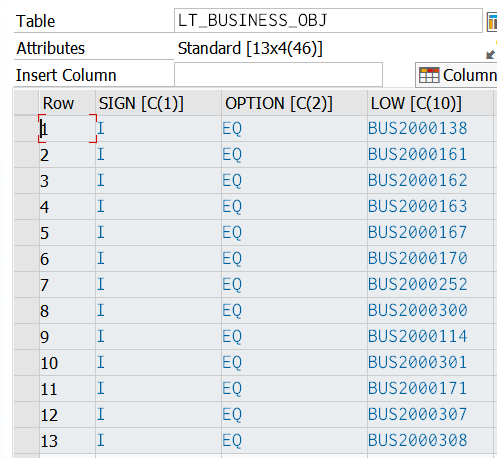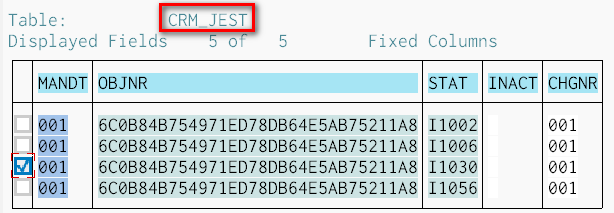
- SAP Community
- Products and Technology
- CRM and Customer Experience
- CRM and CX Blogs by SAP
- How is status drop down list entry generated in Or...
CRM and CX Blogs by SAP
Stay up-to-date on the latest developments and product news about intelligent customer experience and CRM technologies through blog posts from SAP experts.
Turn on suggestions
Auto-suggest helps you quickly narrow down your search results by suggesting possible matches as you type.
Showing results for
Advisor
Options
- Subscribe to RSS Feed
- Mark as New
- Mark as Read
- Bookmark
- Subscribe
- Printer Friendly Page
- Report Inappropriate Content
05-13-2017
2:56 PM
This blog describes the logic how those status entries in the drop down list are populated.

And it will only focus on the scenario where no status profile maintained for transaction type.

The three entries you see in drop down list are retrieved from this method: CL_CRM_UIU_STATUS_INFO=>GET_STATUS_INFO

These three entries are generated via the following steps.
Step1. fetch all entries from table which is marked as active and is lifecycle status ( lifecycle flag <> space ), there are totally 47 records in my system.


Step2. Loop these 47 records to filter out those which do not fulfill some requirement.


For example, system I1003 ( in process ) combined with business process LCAC will be filtered out, because business process LCAC is not configured as permitted process for COH in table TJ05.

I1003 with LIPR is also filtered out but due to another reason that the customizing says only the following 13 object types are allowed,

and current service order has object type BUS2000116 which is not included, as a result I1003 with process LIPR should never appear in final drop down list.

This is the result which survives from the filtering in the first round.

Step3. Loop the result from previous step, call CRM_STATUS_MAINTAIN_OW to check whether the currently looped status could be reached.

This check is internally done via CRM_STATUS_CHANGE_FOR_ACTIVITY:

After the check of this function module is done, the four highlighted entries below are further filtered out. So finally in WebUI you can only see three entries: Open, In Process and Completed.

You can use the following report to trigger this check:
REPORT crms4_status_check.
PARAMETERS: o_guid TYPE crmt_object_guid OBLIGATORY DEFAULT '6C0B84B754971ED78DB64E5AB75211A8',
process TYPE tj01-vrgng OBLIGATORY DEFAULT 'INPR'.
DATA: lv_not_allowed TYPE abap_bool,
lv_error TYPE abap_bool,
lv_obj_not_found TYPE abap_bool,
lv_status_inconsistent TYPE abap_bool,
lv_status_not_allowed TYPE abap_bool,
lv_warning TYPE abap_bool.
CALL FUNCTION 'CRM_STATUS_CHANGE_FOR_ACTIVITY'
EXPORTING
check_only = 'X'
objnr = o_guid
vrgng = process
xnoauto = 'X'
IMPORTING
activity_not_allowed = lv_not_allowed
error_occurred = lv_error
object_not_found = lv_obj_not_found
status_inconsistent = lv_status_inconsistent
status_not_allowed = lv_status_not_allowed
warning_occurred = lv_warning
EXCEPTIONS
activity_not_allowed = 1
object_not_found = 2
status_inconsistent = 3
status_not_allowed = 4
wrong_input = 5
warning_occured = 6.
CASE sy-subrc.
WHEN 1.
WRITE:/ 'activity not allowed'.
WHEN 2.
WRITE:/ 'order not found'.
WHEN 3.
WRITE:/ 'status inconsistent'.
WHEN 4.
WRITE:/ 'status not allowed'.
WHEN 5.
WRITE:/ 'wrong input'.
WHEN 6.
WRITE:/ 'warning occurred'.
WHEN 0.
WRITE:/ 'this business process could be successfully carried out' COLOR COL_GROUP.
ENDCASE.For example when you specify business process as RELE, it will print out “activity not allowed".
Why RELE is now allowed for current service order? Query table CRM_JEST with order guid, you can find this order has system status I1030 error.

Go to tcode BS22, find system status I1030 with business transaction RELE, here you can find the corresponding action is set as Forbidden.

In the backend this setting is stored in table TJ07:

- SAP Managed Tags:
- SAP Customer Relationship Management
You must be a registered user to add a comment. If you've already registered, sign in. Otherwise, register and sign in.
Labels in this area
-
Business Trends
270 -
Business Trends
13 -
chitchat
1 -
customerexperience
1 -
Event Information
256 -
Event Information
18 -
Expert Insights
30 -
Expert Insights
52 -
Life at SAP
133 -
Life at SAP
1 -
Product Updates
666 -
Product Updates
32 -
SAP HANA Service
1 -
SAPHANACloud
1 -
SAPHANAService
1 -
Technology Updates
453 -
Technology Updates
15
Related Content
- Implementing Dynamic Case Flows Based on Case Type in CRM and CX Blogs by Members
- CRM Basic Technical Info for ABAPers in CRM and CX Blogs by Members
- SAP Sales Cloud: 2023 Wrap-up and Forward Direction in CRM and CX Blogs by SAP
- Sales & Service Cloud - Intelligent Sales Add-on – 2402 features in CRM and CX Blogs by SAP
- Enhance your Sales Growth and Quotation Efficiency through the Power of SAP Commerce and Sales Cloud in CRM and CX Blogs by SAP
Top kudoed authors
| User | Count |
|---|---|
| 3 | |
| 3 | |
| 2 | |
| 2 | |
| 2 | |
| 1 | |
| 1 | |
| 1 | |
| 1 | |
| 1 |